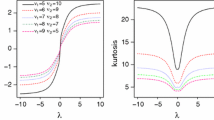Abstract
A new robust class of multivariate skew distributions is introduced. Practical aspects such as parameter estimation method of the proposed class are discussed, we show that the proposed class can be fitted under a reasonable time frame. Our study shows that the class of distributions is capable to model multivariate skewness structure and does not suffer from the curse of dimensionality as heavily as other distributions of similar complexity do, such as the class of canonical skew distributions. We also derive a nested form of the proposed class which appears to be the most flexible class of multivariate skew distributions in literature that has a closed-form density function. Numerical examples on two data sets, i) a data set containing daily river flow data recorded in the UK; and ii) a data set containing biomedical variables of athletes collected by the Australian Institute of Sports, are demonstrated. These examples further support the practicality of the proposed class on moderate dimensional data sets.





Similar content being viewed by others
Notes
obtained from the UK environment agency website; https://environment.data.gov.uk/hydrology/explore
References
Arellano-Valle RB, Azzalini A (2006) On the unification of families of skew-normal distributions. Scand J Stat 33(3):561–574
Arellano-Valle RB, Ferreira CS, Genton MG (2018) Scale and shape mixtures of multivariate skew-normal distributions. Journal of Multivariate Analysis 166:98–110
Arellano-Valle RB, Genton MG (2005) On fundamental skew distributions. J Multivar Anal 96(1):93–116
Arellano-Valle RB, Genton MG (2010a) Multivariate unified skew-elliptical distributions. Chilean J Stat 1(1):17–33
Arellano-Valle RB, Genton MG (2010b) Multivariate extended skew-t distributions and related families. Metron 68(3):201–234
Arnold BC, Beaver RJ (2000) The skew-Cauchy distribution. Stat Probab Lett 49(3):285–290
Azzalini A (1985) A class of distributions which includes the normal ones. Scand J Stat 12(2):171–178
Azzalini A (1986) Further results on a class of distributions which includes the normal ones. Statistica 46(2):199–208
Azzalini A, Capitanio A (1999) Statistical applications of the multivariate skew normal distribution. Journal of the Royal Statistical Society: Series B (Statistical Methodology) 61(3):579–602
Azzalini A, Capitanio A (2003) Distributions generated by perturbation of symmetry with emphasis on a multivariate skew t-distribution. Journal of the Royal Statistical Society: Series B (Statistical Methodology) 65(2):367–389
Azzalini A, Valle AD (1996) The multivariate skew-normal distribution. Biometrika 83(4):715–726
Branco MD, Dey DK (2001) A general class of multivariate skew-elliptical distributions. J Multivar Anal 79(1):99–113
Byrd RH, Hansen SL, Nocedal J, Singer Y (2016) A stochastic quasi-Newton method for large-scale optimization. SIAM J Optim 26(2):1008–1031
Cook RD, Weisberg S (1994) Transforming a response variable for linearity. Biometrika 81(4):731–737
Cambanis S, Huang S, Simons G (1981) On the theory of elliptically contoured distributions. J Multivar Anal 11(3):368–385
Fang KT, Kotz S, Ng KW (1990) Symmetric multivariate and related distributions. Chapman and Hall, London
Ferreira CS, Lachos VH, Bolfarine H (2016) Likelihood-based inference for multivariate skew scale mixtures of normal distributions. AStA Adv Stat Anal 100:421–441
Frühwirth-Schnatter S, Pyne S (2010) Bayesian inference for finite mixtures of univariate and multivariate skew-normal and skew-t distributions. Biostatistics 11(2):317–336
Genton MG, Loperfido NM (2005) Generalized skew-elliptical distributions and their quadratic forms. Ann Inst Stat Math 57(2):389–401
Gonzalez-Farias G, Dominguez-Molina JA, Gupta AK (2004) The closed skew-normal distribution. In: Genton MG (ed) Skew-elliptical distributions and their applications: a journey beyond normality. Chapman and Hall/CRC, Boca Raton, pp 25–42
Gupta AK (2003) Multivariate skew t-distribution. Statistics: A Journal of Theoretical and Applied Statistics 37(4):359–363
Kelker D (1970) Distribution theory of spherical distributions and a location-scale parameter generalization. Sankhyā: The Indian Journal of Statistics, Series A, pp 419–430
Kahrari F, Rezaei M, Yousefzadeh F, Arellano-Valle RB (2016) On the multivariate skew-normal-Cauchy distribution. Stat Probab Lett 117:80–88
Lachos VH, Ghosh P, Arellano-Valle RB (2010) Likelihood based inference for skew-normal independent linear mixed models. Stat Sin, pp 303–322
Liseo B, Loperfido N (2003) A Bayesian interpretation of the multivariate skew-normal distribution. Stat Probab Lett 61(4):395–401
Liseo B, Parisi A (2013) Bayesian inference for the multivariate skew-normal model: A population Monte carlo approach. Comput Stat Data Anal 63:125–138
Ma Y, Genton MG (2004) Flexible class of skew-symmetric distributions. Scand J Stat 31(3):459–468
Moritz P, Nishihara R, Jordan M (2016) A linearly-convergent stochastic L-BFGS algorithm. In: Artificial Intelligence and Statistics, pp 249–258
Pyne S, Hu X, Wang K, Rossin E, Lin T-I, Maiera LM, Baecher-Allan C, McLachlan GJ, Tamayo P, Hafler DA, De Jagera PL, Mesirov JP (2009) Automated high-dimensional flow cytometric data analysis. Proc Natl Acad Sci 106(21):8519–8524
Sahu SK, Dey DK, Branco MD (2003) A new class of multivariate skew distributions with applications to Bayesian regression models. Canadian J Stat 31(2):129–150
R Core Team (2019) R: a language and environment for statistical computing r foundation for statistical computing. Vienna, Austria. URL https://www.R-project.org/
Wang J, Boyer J, Genton MG (2004) A skew-symmetric representation of multivariate distributions. Stat Sin, pp 1259–1270
Acknowledgments
The authors would like to thank the Editor, the Associate Editor and the referee for careful reading and comments which greatly improved the paper.
Author information
Authors and Affiliations
Corresponding author
Additional information
Publisher’s Note
Springer Nature remains neutral with regard to jurisdictional claims in published maps and institutional affiliations.
Appendix A:: Proofs
Appendix A:: Proofs
1.1 A.1 Proof that (1) is a pdf
Note that
and therefore (1) is a valid pdf.
1.2 A.2 Proof of (7)
Note that
1.3 A.3 Proof of (11)
Note that
1.4 A.4 Proof of (12)
By Hölder’s inequality,
Rights and permissions
About this article
Cite this article
Kwong, H.S., Nadarajah, S. A New Robust Class of Skew Elliptical Distributions. Methodol Comput Appl Probab 24, 1669–1691 (2022). https://doi.org/10.1007/s11009-021-09883-5
Received:
Revised:
Accepted:
Published:
Issue Date:
DOI: https://doi.org/10.1007/s11009-021-09883-5
Keywords
- Maximum likelihood estimation
- Multivariate distributions
- Multivariate skew t distributions
- Robust distributions



